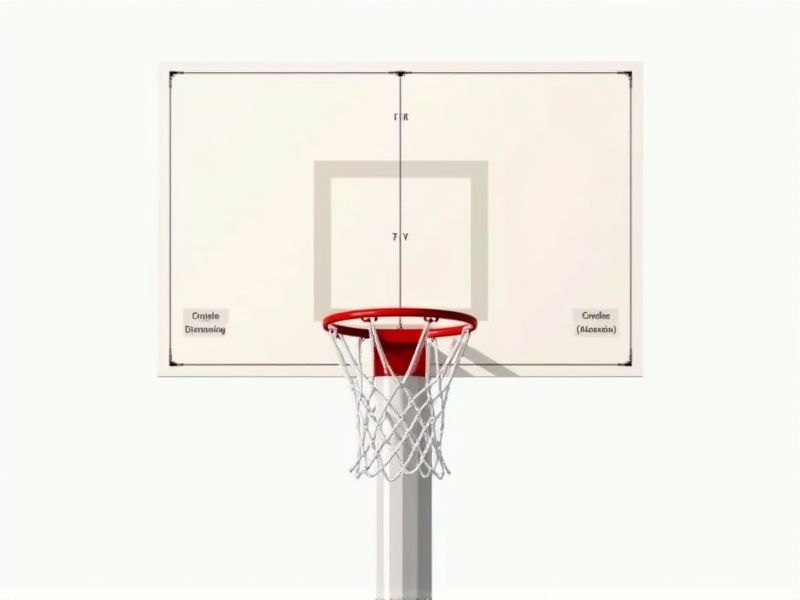
A standard basketball hoop features a rim with a diameter of 18 inches (45.7 centimeters), securely attached to a backboard. The top edge of the rim is positioned 10 feet (3.05 meters) above the playing surface, which is a consistent height for both professional and amateur play. The rectangular backboard itself typically measures 6 feet (1.83 meters) wide and 3.5 feet (1.07 meters) tall. Understanding these dimensions is helpful whether you're installing a hoop at home or ensuring your court meets competition standards.
Rim Diameter
The standard basketball hoop has a rim diameter of 18 inches, a measurement set by governing bodies like the NBA and FIBA. This diameter ensures uniformity across different levels of play, making it an essential aspect of the sport. In high school, college, and professional leagues, players shoot at the same rim size, which impacts shooting techniques and strategies. Knowing the rim diameter can help you better understand game dynamics and improve your shooting accuracy.
Rim Height From Floor
The standard rim height for basketball hoops is set at 10 feet (3.05 meters) above the playing surface. This regulation applies to all levels of play, including youth, high school, college, and professional games. For younger players, adjustable hoops are often utilized, allowing for rim heights ranging from 6.5 feet (1.98 meters) to the regulation height, promoting skill development. Ensuring the correct rim height is essential for maintaining consistency in gameplay and player performance.
Backboard Dimensions
The official dimensions for a basketball hoop backboard are 6 feet wide and 3.5 feet tall. The backboard's surface is typically made of fiberglass, acrylic, or tempered glass, providing durability and optimal rebound quality. For optimal placement, the bottom edge of the backboard should be 9 feet 6 inches above the court surface, while the hoop itself is positioned 10 feet above the ground. Understanding these dimensions is crucial for maintaining standard conditions in both recreational and competitive basketball settings.
Free Throw Line Distance
The standard distance from the free throw line to the basketball hoop is 15 feet (4.57 meters). This regulation is essential for maintaining consistency in gameplay across all levels, from amateur to professional. Without this distance, the shooting dynamics and strategy would vary, affecting player performance and statistical outcomes. Your understanding of this measurement can enhance your shooting technique and improve your overall game.
Three-Point Line Distance
The standard distance for a professional basketball three-point line is 23.75 feet (7.24 meters) from the basket at the arc's furthest point, with a minimum distance of 22 feet (6.7 meters) in the corners. In NCAA competitions, the three-point line is set at 22.1 feet (6.7 meters) from the basket. Understanding these measurements is crucial as they significantly influence shooting strategies for players and teams. By familiarizing yourself with these distances, you can improve shooting accuracy and game performance.
Key (Paint) Area Dimensions
The key area, commonly known as the paint, measures 16 feet wide and 19 feet long in NBA regulations, while in college basketball, it is slightly narrower at 12 feet. The free-throw line is positioned 15 feet from the backboard, enhancing your shooting strategy. Within this zone, the three-second violation rule applies, requiring players to exit the paint after three seconds of occupancy unless actively involved in a play. Understanding these dimensions is crucial for developing effective offensive and defensive plays around the basketball hoop.
No Charge Semicircle Radius
The no-charge semicircle radius for a standard basketball hoop is set at 4 feet (1.22 meters) from the center of the basket, forming an arc beneath the hoop. This area is crucial for player safety and fair play, as it delineates where charging fouls cannot be called on offensive players driving to the basket. Understanding the no-charge semicircle can enhance your gameplay strategy, allowing you to maneuver effectively while minimizing personal fouls. In high school and college basketball, this standard ensures consistency across different playing environments.
Backboard Material
The backboard of a standard basketball hoop is typically made from materials like glass, acrylic, or plywood, each offering unique benefits. Glass backboards, commonly used in professional settings, provide superior rebound quality and durability, ensuring a consistent playing experience. Acrylic backboards offer a lighter alternative with good impact resistance, making them suitable for home and recreational use. Plywood, while less popular, provides a cost-effective option but may not deliver the same level of performance compared to other materials.
Net Length
A standard basketball hoop features a net length of 15 inches, allowing for optimal gameplay and ball interaction. This specification is part of the official regulations set by governing bodies, such as the NBA and FIBA. The net, typically made of durable nylon or heavy-duty polyester, provides a reliable and consistent experience for players at all levels. Ensuring your hoop adheres to this net length can enhance your practice sessions and improve shooting accuracy.
Rim Color
When selecting a basketball hoop, the color of the rim can significantly impact visibility and aesthetics. Most standard hoops feature a shiny metal rim, typically painted red or orange, enhancing its prominence on the court. Research indicates that brighter colors stimulate better focus and tracking, improving your shooting accuracy. Choosing a vibrant rim color can inspire players, particularly youth athletes, fostering a greater enthusiasm for the game.
